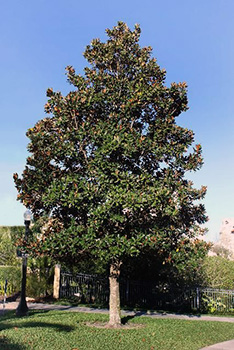Southern Magnolia
Magnolias come in all shapes and sizes, but perhaps the most well-known magnolia in Florida is the Southern magnolia, Magnolia grandiflora.

These stately trees can grow up to 90 feet tall, depending on the cultivar, and have lustrous, evergreen foliage that makes a great backdrop for other garden plants. In the spring and summer, Southern magnolias produce creamy white flowers that have a lemony smell and can be as large across as dinner plates.
Southern magnolias are often planted as specimen trees, but a row of magnolias can also make a great screen for blocking unsightly views or establishing a boundary between adjoining properties. Some Southern magnolias can even be trained as an espalier plant if you’re willing to invest the time!
Planting
Southern magnolias can be planted in sun or shade and prefer moist, well-drained, acidic soils. It’s a good idea to plant Southern magnolias within defined landscape beds rather than a lawn, since the trees shed leaves and seedpods each spring and also produce surface roots over time.
Make sure you know how large the tree will be when it is mature and select a site that will provide it ample room to grow.
You can plant container-grown trees at any time of year, but plant balled-and-burlapped trees from August through October. Dig the planting hole at least two times wider than the root ball and nearly as deep as the root ball.
Place the tree in the hole so that the surface of the root ball is slightly higher than the surrounding ground. Backfill the hole with soil and water thoroughly. Finally, apply 3 to 4 inches of mulch around the tree, but leave the rootball uncovered as the mulch can prevent water from reaching the rootball.
If your tree drops a number of leaves during the first season, don’t be alarmed—transplant shock is fairly common with Southern magnolia.
Care
Continue to give the tree regular applications of water to help it get established. After the first four to six weeks, you can fertilize with light—but frequent—applications during the first three growing seasons.
Unless maintenance is a problem, leave the lower branches of the tree intact. However, you can prune lightly to remove any stray limbs or to help the tree grow into a pleasing pyramidal shape.
Popular Cultivars
- ‘Bracken’s Brown Beauty’
- Claudia Wannamaker’
- ‘D.D. Blanchard’
- ‘Edith Bogue’
- ‘Glen St. Mary’
- ‘Hasse’
- ‘Little Gem’
- ‘Majestic Beauty’
- ‘Margaret Davis’
- ‘Russet’
- ‘Samuel Sommer’
- ‘Symmes Select’
- ‘Timeless Beauty’
- ‘Victoria’

